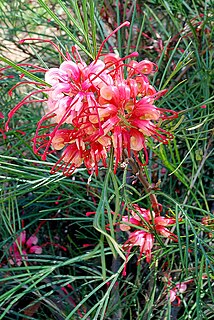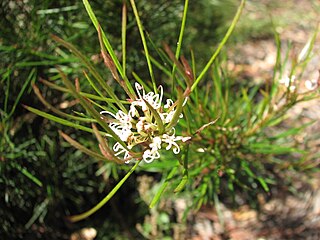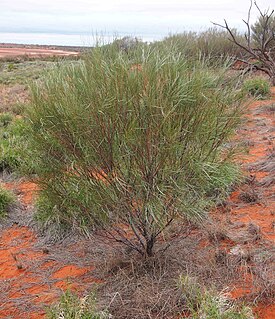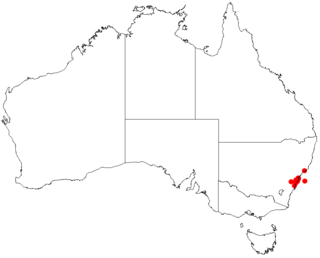
Epacris impressa, also known as common heath, is a plant of the heath family, Ericaceae, that is native to southeast Australia. French botanist Jacques Labillardière collected the species in 1793 and described it in 1805. Four forms have been identified, but no subspecies are recognised. Growing in heathland, shrubland or open forest, it is generally a small shrub around 0.5 to 1 m tall, with small stiff leaves. The red, pink or white tube-like flowers appear from late autumn to early spring. Honeyeater birds, particularly the eastern spinebill, feed upon the nectar of the flowers. It regenerates after bushfire by seed or by resprouting.

Darwinia, sometimes commonly known as mountain bells or simply bells, is a genus of about 70 species of evergreen shrubs in the family Myrtaceae, endemic to southeastern and southwestern Australia. The majority are native to southern Western Australia, but a few species occur in South Australia, New South Wales and Victoria. The genus was named in honour of Erasmus Darwin, grandfather of Charles Darwin by Edward Rudge in 1816. Most darwinias grow to a height of between 0.2 and 3 m, and many are prostrate shrubs. Most have small, simple leaves and the flowers are often grouped together, each flower with five red, white or greenish petals and ten stamens. In many species, the flowers are surrounded by large, colourful bracts, giving rise to their common names.

Baeckea is a genus of flowering plants in the myrtle family, Myrtaceae. There are about 75 species, of which 70 are endemic to Australia; the others are distributed in New Caledonia and Southeast Asia.

Blandfordia grandiflora, commonly known as Christmas bells, is a flowering plant endemic to eastern Australia. It is a tufted perennial herb with narrow, channelled, linear leaves and between two and twenty large, drooping, bell-shaped flowers. The flowers are red with yellow tips, or sometimes entirely yellow. It is one of four species of Blandfordia known as Christmas bells, this one growing on the coast and nearby ranges between Sydney in New South Wales and Fraser Island in Queensland.
Verticordia verticordina is a flowering plant in the myrtle family, Myrtaceae and is endemic to a small area near the coast of the south-west of Western Australia. It is a small, low-growing shrub with crowded leaves and in spring, scattered pale greenish-cream and golden brown flowers. Its unusual flowers and fleshy leaves give the plant a superficial resemblance to a Darwinia.

Laxmannia is a genus of tufted perennial herbs in the family Asparagaceae, subfamily Lomandroideae, that are endemic to Australia.

Darwinia taxifolia is a shrub which is endemic to New South Wales in Australia.

Darwinia meeboldii, the Cranbrook bell, is a shrub which is endemic to the south-west of Western Australia. It has an erect and straggly habit, growing to between 0.5 and 3 metres high. The bracts around the flowers form a pendent "bell" which is usually white with red tips. A group of 8 small flowers are concealed inside. These are primarily produced between August and November.

Ottochloa is a genus of African, Asian, and Australian plants in the grass family.

Grevillea johnsonii is a shrub species which is endemic to New South Wales in Australia.

Darwinia fascicularis is shrub in the myrtle family and is endemic to areas near Sydney. A small shrub with aromatic foliage and white flowers, turning red as they mature. Nectar feeding birds are attracted to its flowers as a food source.

Grevillea neurophylla, commonly known as granite grevillea, is a shrub species in the family Proteaceae. It is native to the states of New South Wales and Victoria in Australia. The species was first formally described by French botanist Michel Gandoger in Bulletin de la Société Botanique de France in 1919. There are two subspecies:
Grevillea patulifolia, commonly known as swamp grevillea, is a shrub species in the family Proteaceae. It is native to the states of New South Wales and Victoria in Australia.
Grevillea polybractea, commonly known as crimson grevillea, is a shrub species in the family Proteaceae. It is native to the states of New South Wales and Victoria in Australia.
Grevillea epicroca is a shrub species that is endemic to south-eastern New South Wales in Australia. It grows up to 2.5 metres high and produces clusters of red flowers between November and May in the species' native range. It was first formally described by Val Stajsic and Bill Molyneux, their description published in Flora of Australia in 2000.

Darwinia micropetala, commonly known as small darwinia, is a small shrub that is native to south-eastern Australia. It grows to 0.5 metres high and has small leaves and clusters of small white and pink flowers that appear between June and December in the species' native range.

Grevillea juncifolia, commonly known as the honeysuckle grevillea, honey grevillea and honeysuckle spider flower, is a shrub or small tree species that is native to inland Australia. It grows to between 2 and 7 metres high. The yellow or orange flowers appear all your round, peaking between July and November in the species' native range.

Grevillea ramosissima, commonly known as fan grevillea, is a shrub species of the family Proteaceae. It is native to south-eastern Australia.

Darwinia diminuta is a plant in the myrtle family Myrtaceae and is endemic to New South Wales. A small spreading shrub with white to pinkish tubular flowers arranged in pairs, with a restricted distribution mostly in the Sydney region.
Barbara Lynette Rye is an Australian botanist born in 1952.
















